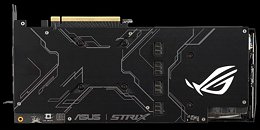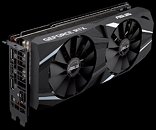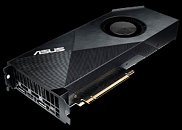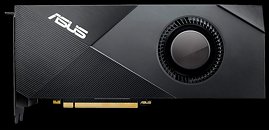Monday, September 17th 2018

ASUS Announces Its NVIDIA RTX 2070 Graphics Card Lineup
ASUS has revealed their entire lineup, interpreting NVIDIA's RTX 2070 silicon (and its TU106 die, a first - remember that **70-class cards previously featured cut-down versions of the full NVIDIA chip). There aren't many surprised here - ASUS has already spent enough R&D in previous years so as to only need to minimally iterate on their designs for each new generation.
The ROG Strix graphics cards sit at the top of the heap, featuring the company's DirectCU III cooling tech (triple fan) in a 2.5-slot design. RGB lighting and dual BIOS support are par of the course by now, as are some of the other features - backplate and metal brace included. Connectivity-wise there are 2x HDMI 2.0b ports, 2x DisplayPort 1.4 outputs, and 1x USB Type-C port for VirtuaLink. The graphics card draws power from the 6-pin and 8-pin PCIe power connectors and will be available in three versions (Gaming OC, Gaming Advanced, and Gaming) according to factory overclocks.Next up is the Dual lineup, which cuts on some frills and thrills (RGB lighting and one extra fan, for example), increases the thickness of the cooling solution to a 2.7-slot affair, but reduces its overall length. Connectivity is taken care of by 1x HDMI 2.0b port, 3x DisplayPort 1.4 outputs, and 1x USB Type-C port. The Dual too draws power from 6-pin and 8-pin PCIe power connectors and will be available in three versions (Dual OC, Dual Advanced, and Dual Gaming) according to factory overclocks.Finally, ASUS' Turbo version will be the cheapest option, with the ages-old blower-type cooler design (with a single 80 mm fan) that should be easily outperformed by NVIDIA's own reference cooling solution. It keeps the 2.7-slot cooling solution as the DUAL, adds a little LED bling, and changes little in connectivity: 1x HDMI 2.0b port, 3x DisplayPort 1.4 outputs, and 1x USB Type-C port.
Source:
Tom's Hardware
The ROG Strix graphics cards sit at the top of the heap, featuring the company's DirectCU III cooling tech (triple fan) in a 2.5-slot design. RGB lighting and dual BIOS support are par of the course by now, as are some of the other features - backplate and metal brace included. Connectivity-wise there are 2x HDMI 2.0b ports, 2x DisplayPort 1.4 outputs, and 1x USB Type-C port for VirtuaLink. The graphics card draws power from the 6-pin and 8-pin PCIe power connectors and will be available in three versions (Gaming OC, Gaming Advanced, and Gaming) according to factory overclocks.Next up is the Dual lineup, which cuts on some frills and thrills (RGB lighting and one extra fan, for example), increases the thickness of the cooling solution to a 2.7-slot affair, but reduces its overall length. Connectivity is taken care of by 1x HDMI 2.0b port, 3x DisplayPort 1.4 outputs, and 1x USB Type-C port. The Dual too draws power from 6-pin and 8-pin PCIe power connectors and will be available in three versions (Dual OC, Dual Advanced, and Dual Gaming) according to factory overclocks.Finally, ASUS' Turbo version will be the cheapest option, with the ages-old blower-type cooler design (with a single 80 mm fan) that should be easily outperformed by NVIDIA's own reference cooling solution. It keeps the 2.7-slot cooling solution as the DUAL, adds a little LED bling, and changes little in connectivity: 1x HDMI 2.0b port, 3x DisplayPort 1.4 outputs, and 1x USB Type-C port.














11 Comments on ASUS Announces Its NVIDIA RTX 2070 Graphics Card Lineup
Either way, the 2070 blowers interest me. If I'm lucky, it will also be a cheap way to add USB-c gen2 to this computer (short of replacing the MB, CPU, RAM).
The Turbo version will provide nice clean look with single slot video outputs on the back instead of this double decker thing USBc with Dport on top found on the FE pcb.
Yeah but why, 8nm is just around the corner, If I am buying this, Im selling it 4 months later in perfect condition, nothing touched or modified. with minimal financial loss. I do not want to own it, to show how good it looks, to watercool it under 50C or whatever.
I have no time to play with watercooling and touch the original condition of card and for what.
20 series was designed for 10nm, nextgen is 8nm, so this is too old now. No time to enjoy.
No point thinking longtherm possessing a video card. Not unless 7nm is out, and 5nm is 5 years away.
Yeah and about sagging. I keep my PC with the front side facing down, GPu suspended vertically.